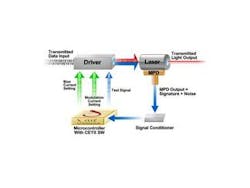Eliminating measurement errors in optical transceivers
A new software-enabled control technology enables laser manufacturers to produce low-cost transceivers that automatically adjust laser performance for consistent operation over time.
By Jorge P. Sanchez
CEYX Technologies
Today's optical transceivers are plagued by significant errors--caused by laser aberrations due to temperature, aging, nonlinearities, and manufacturing variations--that affect system performance and lead to data transmission errors. As a result, OEMs are demanding more efficient transceiver solutions with broader applications. There is a pressing need for standardization and re-usability, lower costs, and shorter time to market. Moreover, as low-cost optical networks become pervasive, transceivers must incorporate automated self-adjustment, early degradation detection, and failure reporting.
When a laser is installed in an optical transmitter, the optical transceiver manufacturer sets predetermined amounts of power corresponding to the logic high and low signals (binary 1s and 0s) used in data transmission. Over time, as age and heat degrade laser performance, the difference between these logic highs and lows narrows, and errors begin to appear.
Another factor to consider is a reduction of the laser's threshold. If adjustments aren't made, the average optical power (AOP) will change significantly as the laser ages or as temperature changes occur.
Eliminating measurement errors
A variety of methods currently are used to control key performance metrics, including monitor photodiodes (MPDs), temperature sensors, and look-up tables. But each of these methods has proven inadequate for precisely measuring transceiver performance over time and temperature.
Monitor photodiodes
Lasers are typically packaged in transmitter optical subassemblies (TOSAs) that contain the laser, an MPD, and other elements such as lenses, PC-board connections, and fiber-optic alignment features. MPDs are commonly used to determine laser brightness and laser performance levels by detecting a proportional amount of the laser signal to determine how much power the laser is producing. Normally, these sensors can't see the true height of the square waves that define the laser signal; they can only determine the average power at various temperature points. As a result, MPDs cannot provide the precise control information required to accurately set the modulation current needed to set extinction ratio (ER) and optical modulation amplitude (OMA).
Temperature sensors
Today's inexpensive temperature sensors cannot accurately determine laser temperatures because their readings--much like thermometer readings--depend in part on where they are mounted on the laser transceiver. With no ideal location for mounting sensors close to the laser, a degree of uncertainty is introduced into the temperature readings, which results in additional performance errors.
Look-up tables
Currently, there is no precise method for determining when a laser has aged to the point when it must be replaced. Traditionally, laser product manufacturers generate temperature compensation tables or look-up tables to track and measure the amount of laser current required for a given temperature. These tables are generated by extensively testing and measuring how much current is required to obtain certain measured laser signals under varying temperature conditions, enabling manufacturers to correlate operating parameters with temperature changes.
Look-up tables present several problems for manufacturers. First, the resulting values are not exact; they are approximations. Second, testing is done when the laser is new. As soon as the laser ages, the look-up tables are in error. Third, generating look-up tables is a tedious, time-consuming, and expensive practice.
A new approach for precise measurements
A new software-enabled control technology for managing laser characteristics delivers the precise metrics required to measure edge-emitting and vertical-cavity surface-emitting laser (VCSEL) performance on a moment-by-moment basis. This accuracy offers significant advantages over traditional measurement solutions by:
• Eliminating temperature testing (and thus the need for look-up tables);
• Automatically calibrating manufacturing differences in drivers, lasers, and MPDs;
• Dramatically reducing optical transceiver development time; and
• Compensating for aging.
At the heart of this system is a unique microdetector. Its program is embedded in a low-cost microcontroller unit, which, in combination with internal or external DACs, applies a test signal to the transceiver. This test signal is so minute it does not disrupt transmitted light output (See Figure 1).
An MPD and a simple signal conditioner circuit recover a "signature" of the system's performance from its output. Because this signature is mixed with substantial amounts of "noise," the microdetector uses powerful digital signal processing (DSP) methods to extract the needed system information to derive laser and driver transfer characteristics, slope efficiency, laser threshold, and amount of aging--all without disrupting data transmissions. The control system then provides feedback to digital servos that accurately set the necessary bias and modulation currents to account for system variations.
The software-enabled control system features several firmware modules that can be configured to fit virtually any edge-emitter or VCSEL laser, laser driver, or transceiver configuration. The configuration procedure is automated and capable of loading up to several hundred control parameters. Numerous modules for I/O communication, error correction, and manufacturing-test features allow a transceiver manufacturer to customize a solution to fit its particular needs or a given industry standard. A library of modules is available for customization purposes. In addition, manufacturers can rapidly leverage laser-control code for a new application, as well as maintain and update the transceiver with minimal effort. This results in two significant benefits: Reduced R&D development costs and reduced time to market.
Software-enabled control technology enables the creation of next-generation optical transceivers by delivering accurate, real-time performance feedback. The technology allows end users to deliver the precise amount of power required to keep their lasers accurate, dramatically reduces their test time, and warns them when it is time to replace the laser. Moreover, end users will benefit from increased production yields, saving them both time and money.

